
About UsThe Numismatic Bibliomania Society is a non-profit organization promoting numismatic literature. For more information please see our web site at coinbooks.org SubscriptionsThose wishing to become new E-Sylum subscribers (or wishing to Unsubscribe) can go to the following web page link MembershipThere is a membership application available on the web site Membership Application To join, print the application and return it with your check to the address printed on the application. Membership is only $15 to addresses in the U.S., $20 for First Class mail, and $25 elsewhere. For those without web access, write to: David M. Sundman, Treasurer AsylumFor Asylum mailing address changes and other membership questions, contact David at this email address: dsundman@LittletonCoin.com SubmissionsTo submit items for publication in The E-Sylum, just Reply to this message, or write to the Editor at this address: whomren@gmail.com
BUY THE BOOK BEFORE THE COIN |
- WAYNE'S WORDS: THE E-SYLUM AUGUST 4, 2013
- NEW BOOK: COIN COLLECTING ALBUMS, VOLUME ONE
- NEW BOOK: INDO-GREEK RULERS AND THEIR COINS
- NEW BOOK: COIN COLLECTING IN RETIREMENT
- JOHN P. DEVINE 1933-2013
- QUIZ ANSWERS: BABIES ON COINS
- DAVID LANGE ON SECURITY FOR THE ANA'S COIN RARITIES
- QUERY: SEPTEMBER 1968 MERKIN SALE HALF DIME CONSIGNOR SOUGHT
- ERIC SCHENA TEACHES VIRGINIA YOUNG NUMISMATISTS ABOUT TOKENS
- BONHAMS TO SELL TACASYL U.S. PROOF GOLD COINS
- QUERY: 1850S AMERICAN PAPER CURRENCY IMAGES SOUGHT
- HARVEY STACK ON THE GEORGE O. WALTON COLLECTION
- SOME OLYMPIC GOLD MEDALS TO CONTAIN RUSSIAN METEORITE FRAGMENTS
- SMITHSONIAN CURATOR KAREN LEE VISITS SRI LANKA
- JANE AUSTEN BANKNOTE PROMOTER THREATENED
- ISAAC NEWTON'S DEATH MASK
- MISSING KEYS SEARCH LEADS TO 14 MEDIAEVAL COINS
- 'LOVEABLE ROGUE' COUNTERFEITER THOMAS MCANEA DIES
- FACEBOOK IMAGES LEAD TO COUNTERFEITER ARRESTS
- FEATURED WEB PAGE: COIN HOARDS OF THE ROMAN REPUBLIC ONLINE
WAYNE'S WORDS: THE E-SYLUM AUGUST 4, 2013

New subscribers this week include Anthony D'Anna, courtesy of Russ Sears and Jan Bernhard of the Netherlands. Welcome aboard! We have 1,665 email subscribers, plus 242 followers on Facebook.
We're back! But due to my family vacation, this week's issue is late. I haven't been able to respond to everyone's emails yet, but should be able to get many of them into the next issue. We should be back to our regular publishing schedule Sunday. Thank you for your patience.
This week we open with three new numismatic books, word of the death of error book author 'Lonesome' John Devine, and answers to our "Babies on Coins" quiz.
Other topics include the 1968 Merkin sale half dimes, $3 and $4 gold coins, George Walton's gold, and Olympic gold medals containing meteorite fragments.
To learn more about “an excrescence”, Sir Isaac Newton's death mask, John Kraljevich's new web site, David Lange's "Men in Black" traveling companions and Walter Chondrite, read on. Have a great week, everyone!
Wayne Homren
Editor, The E-Sylum
NEW BOOK: COIN COLLECTING ALBUMS, VOLUME ONE
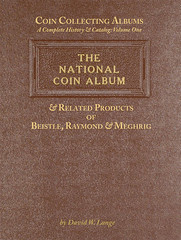 I'm close to publishing my book on National Coin Albums and related products.
The exact title is Coin Collecting Albums - A Complete History & Catalog Volume One: The National Coin Album & Related Products of Beistle, Raymond & Meghrig. It is just under 300 pages, with 80 pages in full color. The book has a hardcover and is printed on 100# paper. This is a very high quality product that is meant to last.
I'm close to publishing my book on National Coin Albums and related products.
The exact title is Coin Collecting Albums - A Complete History & Catalog Volume One: The National Coin Album & Related Products of Beistle, Raymond & Meghrig. It is just under 300 pages, with 80 pages in full color. The book has a hardcover and is printed on 100# paper. This is a very high quality product that is meant to last.
As the title suggests it covers everything to do with the development of all the coin album products produced by The Beistle Company (Unique Coin Holder), Wayte Raymond, Inc. (National Album, Popular Album, Unique Coin Holder, Rayway Coin Holder and Easy Display Coin Filing System) and M. Meghrig & Sons, Inc. (American Album, Green Book, Merit Coin Holder and Gem Coin Album). Each of these companies and their principals are given a full history with many unpublished photographs from family members. Finally, each and every variety of coin holders is thoroughly described and assigned a unique Lange Number for easy communication between collectors.


I'm now taking pre-orders with delivery expected in October. The pre-publication price is $65 plus $10 for priority mail shipping. I hope to be able to hold this price after publication, but there are still some variables pending, and the price may have to go up. I'll have a sample copy of the book at the ANA convention. Anyone who wants to see the book there or place a pre-order can find me at the NGC booth for most of the week. Mail orders may be paid by check made out to me or by PayPal made out to my email address: langedw@msn.com.
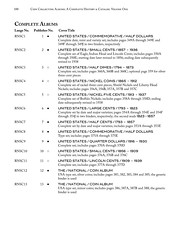

I am also offering a close-out special on my previous book, Coin Collecting Boards of the 1930s & 1940s: A Complete History, Catalog and Value Guide. This popular title provides a similar treatment to the large, one-piece coin boards which kick-started the coin collecting hobby during the Great Depression. Published at $39.95, this title is now just $20.
Mail orders must include $10 for priority mail shipping of the new coin album book. If the earlier coin board book is also ordered, the shipping cost for both is $12. All books purchased from David W. Lange will be signed, and personalized inscriptions are available upon request.
David W. Lange
POB 110022
Lakewood Ranch, FL 34211
941-586-8670
www.coincollectingboards.net
NEW BOOK: INDO-GREEK RULERS AND THEIR COINS
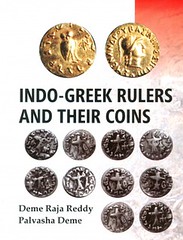 The coins issued by Indo-Greek rulers have proved to an invaluable source for the reconstruction of the political history of the North-West India of ancient times. The other source materials of the period such as literary works and inscriptions are very meager and whatever is known about those kings is mostly derived from their unique coins.
The coins issued by Indo-Greek rulers have proved to an invaluable source for the reconstruction of the political history of the North-West India of ancient times. The other source materials of the period such as literary works and inscriptions are very meager and whatever is known about those kings is mostly derived from their unique coins.
The Indo-Greek rulers were very innovative and issued bilingual coins which have a special niche in Indian coins since they helped in the decipherment of ancient Indian scripts namely Kharoshthi and Brahmi. This led to the study of Indian epigraphy and it has been authoritatively estimated that 80% of our Knowledge of the history of India before 1000 AD is derived from inscriptional sources. There were also other important aspects of Indo-Greek coins.
The Indo-Greek coins presented the portraits of the rulers on the obverse side with a Greek legend around it. The reverse depicted a deity and monograms. The chronology of Indo-Greek rulers is mainly based on the numismatic evidence on the coins. The sources of Indo-Greek coins have been the hoards numbering around 34 and this book describes a new and large hoard of Indo-Greek silver coins numbering about 689. There were coins of three Indo-Greek kings namely Apollodotus II, Archebios, Dionysios and a Western Kshtrap ruler Nahapana. The book presents the details of these coins and also describes the design of these coins and ways to study them.
Authors (s): Deme Raja Reddy (Author) , Palvasha Deme (Author)
Format: Hardcover
ISBN-13: 9789350501276
Pages: xii+88p., Colour & B/W; Illustrations; Bibiography; 25cm.
Pub. date: 03.08.2013, 1st.ed.
Publisher: B.R. Publishing Corporation
Language (s): English
Bagchee ID: BB80005
List price: US $ 71,00
Bagchee price: US $ 63,90
Member price: US $ 57,51
Usually ships in 1-2 days
Free shipping worldwide on orders over 30$
For more information, or to order, see: Overview for Indo-Greek Rulers and Their Coins (www.bagchee.com/books/BB80005/indo-greek-rulers-and-their-coins)
NEW BOOK: COIN COLLECTING IN RETIREMENT
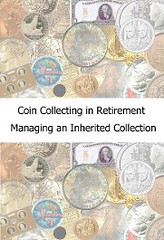 Carlisle Development Corporation announces the release of Coin Collecting in Retirement/Managing an Inherited Collection, by Tom Bilotta. The softcover edition is available at carlisledevelopment.com at $19.95. The book is also available in eBook formats at Amazon.com, Barnes & Noble.com and other eBook resellers.
Carlisle Development Corporation announces the release of Coin Collecting in Retirement/Managing an Inherited Collection, by Tom Bilotta. The softcover edition is available at carlisledevelopment.com at $19.95. The book is also available in eBook formats at Amazon.com, Barnes & Noble.com and other eBook resellers.
Bilotta, the founder of Carlisle Development Corporation has published numismatic software since 1994 and as a result has become very familiar with the needs and experiences of coin collectors, especially those in retirement. The primary focus of the work is to guide numismatists towards approaches which will enable the reader to enhance their enjoyment of coin collecting by adapting their collecting pursuits to accommodate the specialized challenges faced by retirees.
Major topics included in the book are:
- How coin collecting differs during the retirement years
- Selling coins, a new experience for many collectors
- The advantages of simplifying your collection
- Understanding the needs of your family
- Organizing your coin collection for ultimate disposition
- Re-allocating your collection assets to focus on areas of personal interest with new challenges and growth opportunity.
- Estate planning considerate of the specifics of your family and their interest in coin collecting
The second major section focuses on the needs of inheritors of a coin collection:
- How to approach a coin collection
- Approaches to selling different kinds of coins
- Basic information needed to protect/preserve the collection
- Guidance in allocation of time to achieve the best outcome
There are many books targeted to the needs and education of coin collectors, however this is one of the first to focus on the specialized needs of retired numismatists.
For more information, see: carlisledevelopment.com

JOHN P. DEVINE 1933-2013
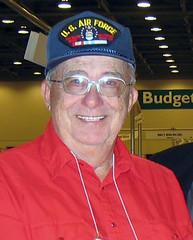 John P. Devine, a founding member of the Combined Organizations of Numismatic Error Collectors Of America (CONECA) and the first inductee into the CONECA Hall of Fame, passed away on July 10, 2013, just a few months short of his 80th birthday. He was a husband, father, grandfather, great grandfather, entrepreneur, mentor, teacher, hobbyist, and friend. He created the Error Coin Museum, which was the umbrella under which the Collectors Of Numismatic Errors (CONE) and the Numismatic Error Collectors Of America (NECA) were able to merge into CONECA in 1983.
John P. Devine, a founding member of the Combined Organizations of Numismatic Error Collectors Of America (CONECA) and the first inductee into the CONECA Hall of Fame, passed away on July 10, 2013, just a few months short of his 80th birthday. He was a husband, father, grandfather, great grandfather, entrepreneur, mentor, teacher, hobbyist, and friend. He created the Error Coin Museum, which was the umbrella under which the Collectors Of Numismatic Errors (CONE) and the Numismatic Error Collectors Of America (NECA) were able to merge into CONECA in 1983.
John's wife, Peggy, is also a CONECA Hall Of Famer, a former CONECA Errorscope Editor and Board Member. John first met her in Harrisburg, Pennsylvania while she was walking home on the Walnut Street Bridge over the Susquehanna River. He tried to pick her up and she didn't accept the ride but did give him her phone number. The rest is history! John had the ability to pick good ones even then. John and Margaret “Peggy” Elizabeth Ewing eloped on June 6th, 1953 -- 28 days after the attempted "pick-up on the bridge" incident. They were married in Towson, Maryland.
They had three children, all girls; one passed shortly after birth. Stella (who would later do a stint editing the Errorscope) was born in 1960 and is married to Rick Knight. They have three college aged boys, Sean, Aaron and Ben. Their daughter, Brenda was born in 1962. She has two boys, Cody and Travis. Cody is in the Army in Dubai, and Travis lives with his wife Kristin and son Aiden in Nevada.
John was preceded in death by his parents, Kieran Agustus and Dorothy Ruth Devine. His sister, Nancy, passed away a few years ago.
John served in the Air Force and had just finished his tour of duty when he met Peggy. In Pennsylvania, there weren't many good jobs. He drove a milk truck, painted cars at the DeSoto dealership, drove a Canada Dry truck, and worked at Jackson Manufacturing making wheel barrows.
John knew there were many jobs in California, so they sold much of the little they had, piled the rest in their '47 Olds convertible and took off for California in a snowstorm! There, he worked for Douglas Aircraft from 1955 to 1960; then Rocketdyne; a short stint at what is now Northrop Grumman Corporation, and a couple of years as an Industrial Engineer at Burroughs.
John had always been interested in coins since he was a kid and met John Burrison at the Conejo Valley Coin Club shortly after he and Peggy moved to Newbury Park, California. He also connected with Duane Spellman through the club.
In the early 1970s John Devine and John Burrison formed a company called John-John Specialties. As I recall, Burrison worked as a co-pilot/navigator for a major airline. This gave them the opportunity to visit many area coin shows and dealers where the flights were scheduled, allowing them to add to their error stock. Devine’s residents was the home base and he put the error coin catalogs together and sold mainly through mail order. There were many layoffs in the engineering field during this time and Devine felt he needed to find more stable employment. Burrison lost interest in the hobby so Devine ended the relationship and started his own error coin mail-order business out of the family's dining room. Spellman suggested the name of "Lonesome John" based on the fact that he was to become the first (and lone) full-time error coin dealer at that time.
The error coin business was later moved from the home to a commercial site in Newbury Park. As the business grew, the printing business evolved due to the difficulty of finding an efficient and reliable printer for the error coin catalogs. John decided he could do it himself better and cheaper. The other tenants in the building came to him for envelopes, letterheads, business cards and fliers. So both the coin business and printing businesses grew and thrived.
Peggy taught John basic computing through her knowledge of word processing. While he was producing his error coin catalogs, The Numismistake, his talent and enjoyment of writing took hold. Not only was he able to incorporate his writing skills into the catalogs, he wrote and published two groundbreaking books entitled, Detecting Counterfeit Coins Book 1 (with a focus on error coins) and Detecting Counterfeit Gold Coins Book 2, the later seeing 19 printings.
He also published many error related books and catalogs for the growing number of dealers and collectors in the field. Probably the most widely known books he published (aside from the ones on counterfeits) were: Paul Marvin and Arnold Margolis', The Design Cud, John Wexler and Tom Miller's, The RPM Book and Wexler's, The Lincoln Cent Doubled Die. He purchased Error-Variety News from Wexler in the 1980s and published it for a number of years. He also published CONECA's journal, the Errorscope-Gram (later simplified to just Errorscope) from the time the club formed until a few years before his retirement.
Heigh Ho Silver Company came into being in the 1970s when Devine and Spellman designed a number of silver art bars. They produced several sexy ones, like "If you can't stand the heat, get out of the kitchen" as well as one on Patty Hearst. Peggy said that John had at least a hundred bars squirreled away all over the place, but she can't find any of them (great hiding places, John).
John enjoyed many things other than coins. The family began camping out weekends in a small trailer. In the mid-1970s he bought their first motor home. Friends and contacts were many in coin collecting, bottle hunting, and metal detecting arenas. They met Marian and Bill Robinson at the Conejo Valley Coin Club. Marian had a metal detector, which interested John immensely, so he bought one. (He would later become a distributer for White's Metal Detectors.) They would go camping together at ghost towns or just out into the desert and scratch for "treasure" and bottles. This evolved into treasure hunting stories of these activities included in John's publications, in particular, in Error-Variety News/The Numismistake (later reverting to just Error-Variety News).
After his retirement he produced profusely illustrated and well documented travelogues sent to many friends via email that included diverse subjects such as: ghost towns, beautiful desert flowers in full bloom after a rain, stands of Saguaro Cacti silhouetted by glorious desert sunsets, glittering gold nuggets, gold flakes, coins, rings, etc. that he and Peggy found prospecting or detecting and more.
John and Peggy owned several homes in Newbury Park, and over the years they owned significant acreage in a variety of locations in Nevada, (the Boundary Peak area, Quartzite, Imlay and Boulder City), which were their bases for gold prospecting mainly throughout Nevada and California. Eventually they started looking in Pahrump, Nevada where they found their final home together. In sharp contrast to their earlier Nevada homes, it was all fenced in with lots of mature trees. Peggy felt safe there, which hadn't always the case in the more remote locations. Their dog Bandit, is a loud barker, and wards off potential intruders.
Knowing John the best, Peggy is almost positive that if he could leave us a message it would be "to listen and learn from others; read and expand your knowledge of coins, their history, and manufacture. Never stop learning!"
John loved the error hobby and the wonderful group of friends he made, many of which he was still in contact with. He touched many people through his life, some more than others. Peggy said, "When he got interested in something, whether it was a job or a hobby, he never went half way - it was all or nothing." Recently he'd grown a full beard because he wanted to be Santa for his great grandson, Aiden, this coming Christmas.
We were all blessed to know this man. Be it as a family member, hobbyist or friend, we all gained something special by crossing paths with Lonesome John. Rest in peace, my friend.
QUIZ ANSWERS: BABIES ON COINS
Last week I wrote:
So here's our quiz from Fred Michaelson: which U.S. coins include an image of a baby? For extra credit, name the baby. One coin should easily come to mind; Fred and I can think of at least three, of which two have names. For collectors outside the U.S., send us images of numismatic items featuring depictions of babies.
Pete Smith got all three. He writes:
The first that came to mind is Virginia Dare on the Roanoke Island Half.
Jean-Baptiste Charbonneau, also known as "Pomp." appears on an infrequently seen coin.
The Elgin, Illinois Half has an unnamed Pioneer woman with an unnamed child in her arms.
I would guess many would miss the Oregon Trail Half. In the wagon is a tiny woman holding something that might be a baby.
Paul Horner offered a more comprehensive list. He writes:
1. Oregon Trail Half Dollar, 1926-39. The pioneers wife is holding their baby.
2. Roanoke Island Half Dollar, 1937. The Baby is of course Virginia Dare.
3. Sacagawea Dollar 2000-. The papoose is her son, Jean Baptiste.
Not! : the 2003 Missouri Quarter. The 3rd person in the boat is not Sacagawea & Jean Baptiste, it is York, a black slave.
4. Another "possible" is the Nebraska Quarter, 2006. One of the riders in the covered wagon may be holding a baby.
5. Also, though not really a baby but a young child, check out the Panama-Pacific Exposition Half Dollar from 1915.
6. Another young child is standing on the 2004 Iowa Quarter.
7. And that's a real babe on the 1992 XXV Olympiad Half Dollar...
8. But no doubt my favorite buxom babe of all is depicted on the 1804 Silver Dollar!
Greg Adams writes:
Jean-Baptiste on Reverse of The Sacagawea Golden Dollar,
Virginia Dare being held by Ellinor Dare on reverse of Roanoke Island, North Carolina: (1937)
Cherub on obverse of 1915 Pan Pacific Expo Dollar
As a bonus… Arguably a baby in Mothers lap while driving the wagon on reverse of Oregon Trail Commem…
&
since you didn’t specify “Human” babies… we also have the Chicks on the back of both the 2008 Bald eagle commemorative and the current Gold bullion pieces.
Fred adds:
I don't believe that we specified that the babies had to be human.

To read the earlier E-Sylum article, see: QUICK QUIZ: BABY COINS (www.coinbooks.org/esylum_v16n31a12.html)
THE BOOK BAZARRE
DAVID LANGE ON SECURITY FOR THE ANA'S COIN RARITIES
I have a story to add to Ken Hallenbeck's account of security surrounding the Bebee 1913 nickel when the ANA acquired it in 1989.
About ten years later I was tasked with being the courier of that coin to from the ANA's vault to NGC's offices, which were then in Parsippany, New Jersey. This nickel was to be certified and graded by NGC as a courtesy to the ANA. At the same time I was also carrying the ANA's two 1804 silver dollars, the Class I Cohen specimen and the Class III Idler coin. All three were inside the small leather briefcase that I carry to every coin show, and these titanic coins were in the company of my own instructional coins brought from home, as well as my meager purchases from the Colorado Springs coin show and, probably, from Ken's shop in town.
It was ANA Summer Seminar week, and I was serving as an instructor when I was received a call from NGC instructing me to meet with then-ANA Curator Robert Hoge. He confirmed what I'd been told by the office---I would be going home with the big three in my possession.
This was fairly early in the week, Tuesday as I recall, and I had butterflies in my stomach for the remainder of the seminar. I was sworn to absolute secrecy, so I couldn't explain to anyone there my sudden loss of appetite. Any person who knows me will understand that this is an extremely rare symptom, indeed.
When the time came to leave on Friday morning I again met with Robert Hoge at the museum, and he turned over the three coins to me at that time. Each was in an large, acrylic holder of the sort made by Capitol Plastics. It was then that I met my two security guards who would escort me to the airport. Now, you have to imagine that in Colorado Springs during the height of summer most people dress casually, shorts and tee shirts being the norm, and this was especially true on campus during seminar week. Nevertheless, my two guards were the original "men in black." Each was dressed in a dark suit and had shades on, even indoors. When they escorted me to the town car parked in front of ANA headquarters it was hard to say which attracted more attention from the students and instructors awaiting their shuttle to the airport---the limo with darkened windows or my two Secret Service-type escorts. I couldn't imagine a more inappropriate manner in which to carry valuables, since I was used to security people who dress like beachcombers to blend in with the crowd.
I was put into the back seat next to one of the guards, while the other drove. During the ride to the airport I was given a tutorial in what to do in the event of an armed hijacking. The guard seated next to me instructed me to respond to the first sign of trouble by bending over underneath the level of the window, and he also informed me that he might have to rest his shot gun on my back while engaged in a running gun battle!
By the time we got to the airport I was already a nervous wreck. I knew that going through security could be a hassle when carrying coins, as I'd been asked to open my bag many times before. This has never been a problem, as I simply ask for a private screening inside one of the rooms set aside for that purpose. The guards are always satisfied, though they do sometimes ask a lot of questions about the 1799-CC trade dollar they bought while in the service overseas. Easy-peasy, right? Oh no---not only did my guards refuse to allow a search of my bag, they also refused to surrender their side arms while going through security. A confrontation ensued, and I was ready to duck at the first sound of gun shots. Somehow, my guards managed to convince the security people that they were licensed to carry guns into the terminal (this was pre-9/11), and we continued on to my gate. There I parted company with the men in black, and they informed me that there were two plainclothes guards already seated within eyesight of me for my protection (actually, it was for the coins' protection). I looked around and made them both very quickly, though they easily could escape detection by someone not looking for them. Most people don't look up from their books every few seconds, and that was a dead giveaway.
It was at this point that a group of seminar students recognized me and came over to chat coins. Of course, this is always the last thing in the world I want to do at the airport, as it can attract the attention of thieves and other nosy people, but I certainly didn't need it when I was carrying three coins then valued at $4 million for the group. "Hi Dave, what'd you buy at the coin show?" was a typical opening line, and I tried to dodge as many questions as possible.
When the time came to board I was at last able to relax, as I didn't imagine anything bad would happen after that point. I was correct, and the flight to New Jersey went quite smoothly. NGC's own security people at the time, Bob and Dan, met me at the Newark airport (dressed casually, of course), and they drove me back to the office. The ANA's three prized superstars were securely locked inside the vault, and I was at last able to reflect back on my wild week at the seminar. In some ways, each one since that time has seemed pretty tame.
To read the earlier E-Sylum article, see: SECURITY FOR THE ANA'S 1913 LIBERTY NICKEL (www.coinbooks.org/esylum_v16n31a10.html)
QUERY: SEPTEMBER 1968 MERKIN SALE HALF DIME CONSIGNOR SOUGHT
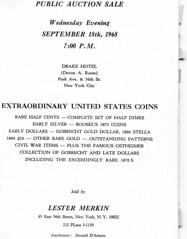 The Lester Merkin Public Auction Sale – September 18, 1968 sale is a favorite sale catalog of mine. Most of my interest has been centered on the over 200 silver dollars consigned to this sale by the Ostheimers.
The Lester Merkin Public Auction Sale – September 18, 1968 sale is a favorite sale catalog of mine. Most of my interest has been centered on the over 200 silver dollars consigned to this sale by the Ostheimers.
In this sale is a wonderful collection or group of early and Seated half dimes 1794-1873. I’ve always wondered who consigned all of these half dimes to this sale. The introduction reads,
Though basically a date and mintmark collection, the present offering is rich enough in rarities and finest knowns to rank with the Helfenstein cents, the collection of dimes in our April 1966 sale, and the Helfenstein /Judd half cents in our March 1968 auction. In researching the collection, we found that extensive offerings of half dimes have been very few in the past generation, the two most important (WGC, Milton Holmes) having a few more early varieties than the present lot but-like the rest-inferior condition in many dates and mintmarks. Because the small size of half dimes makes actual-size illustrations nearly useless, we are picturing the most important specimens in enlargement, the better to display their quite eyebrow-raising quality. To our minds, the 1801, 1803, 1805 and 1853 O No Arrows will not be excelled in the foreseeable future, and are not likely to be equaled in the next generation.
The only pedigree information provided was for Lot 127, the 1802 V-1 half dime: ex. George Walton:459, ex. Century sale:506. The other early half dime rarities mentioned in the introduction were the 1801 V-2 (R-5) in AU+; and the 1803 V-3 Small Date (Borderline R-7), AU; 1805 V-1, BU (Finest Known). There was also a 1794 V-2 (R-6) and a 1797 V-1 Thirteen Stars (R-6). Rarity ratings and commentary are that of the cataloger.
I’ve asked this question to many specialists, numismatists and bibliophiles in the past and will ask it here one more time – does anyone know who consigned this wonderful collection of half dimes to this sale? Can anyone help solve this mystery? Thanks.

ERIC SCHENA TEACHES VIRGINIA YOUNG NUMISMATISTS ABOUT TOKENS
Nummis Nova is a Northern Virginia dinner club of passionate collectors, dealers, writers, and researchers into all things of a numismatic, exonumic, or bibliomaniac bent. Nummis Nova members sponsor an especially successful Young Numismatist event each year at the Annandale Coin Show. Our model might work at your venue, should you wish to promote a new generation of collectors.
This year we expanded into two rooms to hold all the interested kids. Attendees on arrival, are asked to register parent contact information so that reminder/invitation post cards may be mailed to respondents for next year, slated to arrive a week or two in advance of the show. You may simply use email to reduce costs. Newcomer parents fill out the contact information while each child (age 12 or under, or thereabouts) receives an envelope with ten “Auction Bucks.” Auction Bucks are paper scrip used in a live, “kids-only” auction at the conclusion of any business and invited speaker talk.
Donations of coins, tokens, coin supplies and coin books are gathered sporadically during the year, and often supplemented by walking the bourse floor the day before/day of an event, where coin dealers usually have items to give to such a worthy cause. The kids love “old” coins so that any ancient Roman bronze coin or Chinese cash coin of a thousand years age, or obsolete U.S. odd denomination coins or tokens really attract spirited bidding.
Several dozen lots are needed with the exact number to be added to, or subtracted from, as the meeting begins based on attendance count, to ensure each child in attendance has an opportunity to buy something good. The kids may strategically save their Auction Bucks for the next show, or combine money among siblings, to be able to bid more than $10, at which newcomers would max out, for the best lots, which reveals who among the kids, has talent to become our future coin dealers.
Audience participation is spiced up by giving the invited speaker several tens of Auction Bucks to award, or withhold, in one or two dollar incentives for good questions and even better answers from the kids. Once kids catch on how it works, be ready for lively discussion. Speakers are invited to give between 20 minutes and an hour talk, depending on their passion, about what they collect. A projector and laptop allow images of the coins to be displayed without the need to pass around dear examples, among the well-intentioned, fumble fingered audience, and the rest is up to the imagination of the speaker.

This year, the eminent token specialist, Eric Schena, author of The Ingle Scrip of the Mid Atlantic Region, presented “What is a Token – Fun with Exonumia.” In a dozen well-crafted slides, Eric captured the kids’ imagination by addressing unusual aspects of tokens with discussion leading to a take away point they will remember.
For example, from “Tokens are sometimes…Mysterious,” he derives the term “Maverick” meaning a token lacking in information about its place of origin. Eric carried the talk onward with fascinating insights into local tokens that the parents enjoyed too. The kids especially loved Eric’s weird but true stories about tokens from ghost towns, explosive tokens, and tokens forming the last tangible link to historic places, law breaking events, lost treasures and famous persons, with Eric giving the rest of the story at length.
Pay attention, E-Sylum readers, as virtual Auction Bucks may be at stake.
Question 1) What claim to fame does the token from I.T. Banks hold?
Question 2) What are travelers required to do who visit Shaw, WV?
Question 3) What historic event is associated with the Post Exchange token from Fort Mills?
Question 4) which of these tokens are “Mavericks?”
Great stories, Eric. All the trade tokens ever minted in the U.S. from the 1820s to the 1930s, barely equal a day’s production at the U.S. Mint today, making all tokens desirable. Emissions from a hundred to a thousand tokens were the norm putting them on par with the scarcity of Colonial coins. Today we may use e-coupons on iPhones, but back then, tokens were the thing, and I’m sure several new token collectors got their start from Eric’s talk and his generous gift of a three and a half cent merchant token from the turn of the twentieth century, which are not at all common, to each child at the Annandale YN Event, as a new beginning for the collecting bug.
Hints:
Hint 1: A chance discussion in Hollywood assures that everyone knows of the town where this token is from.
Hint 2: It might help to know that Shaw was located along a river.
Hint 3: A famous (recovered) treasure is associated with the place this token hails from.
Hint 4: If we tell you where they are from, would certain tokens still be mavericks? Eric enjoys just this kind of detective work.
BONHAMS TO SELL TACASYL U.S. PROOF GOLD COINS
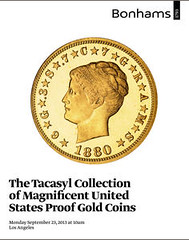 The September 23 Bonhams Coins and Medals auction
includes the "Tacasyl Collection of Magnificent United States Proof Gold Coins" , a "27-strong selection assembled by a private collector of nearly every major American gold coin design in proof between 1836 and 1915." The catalog is available online and the descriptions contain some interesting bits of information about these coins.
-Editor
The September 23 Bonhams Coins and Medals auction
includes the "Tacasyl Collection of Magnificent United States Proof Gold Coins" , a "27-strong selection assembled by a private collector of nearly every major American gold coin design in proof between 1836 and 1915." The catalog is available online and the descriptions contain some interesting bits of information about these coins.
-Editor
Lot 1007, 1885 $3
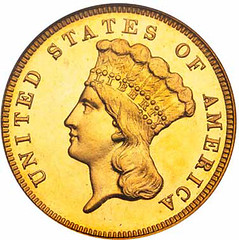

The reasons for creating such an odd denomination remain somewhat hazy, but the first suggestion for the denomination dates back to June, 1832. Whether historically founded or not, numismatists have suggested with some common-sense that the denomination was created to pay for large purchases of 3-cent postage stamps (100 to a sheet). Regardless of the reasoning, the denomination was never popular. (Professor John Alexander, one of the first proponents of an international coinage in the mid-1850s, called the denomination “an excrescence”).
During its entire thirty-five year production from 1854 until 1889 only about 16,300 three dollar gold pieces were produced in total (compared, for example, with the nearly 600,000 Quarter Eagles struck in Philadelphia in 1854 alone). Of that total a meager 2,000 pieces were struck as proofs, and a fraction of those have survived.
Lot 1008 1879 $4 Stella

Although the Stella is undoubtedly America’s best known physical manifestation of an international currency, the idea of coinages which were of equivalent value and convertible in other countries was not new. According to a recent article, in 1855 Professor John H. Alexander published a pamphlet on an international coinage for the United States and Great Britain. The concept was to have the sovereign and half eagle of equal gold content and value. The idea reached the halls of Congress, which subsidized an exploratory trip to Great Britain for the professor, but following Alexander’s report the program failed to win support.
In Europe, the Latin Union was formed in 1865 and seven countries agreed to adopt the French currency system. The members of the Union would produce coins of a national character, but their value and underlying gold content would be based on the French franc. In Paris, two years later at an International Monetary Conference it was agreed (in principal) that all conferees would adopt a similar system, but in subsequent debates the system, largely on nationalistic grounds, was defeated.
France’s defeat in the Franco-Prussian War ended enthusiasm for the idea until 1878, when a second conference was held, again in Paris, at the urging of the United States. This time it was an international bimetallic standard that was proposed and it was as a result of this second conference that the Stellas were developed, largely at the urging of John Kasson, the United States Minister to Austria.
With Congressional approval and the support of the Secretary of State, the Mint was ordered to develop a coin which could not only circulate around the world, be recognized as an international coin, but also indicate its value in a similarly multi-national way.
The Mint’s solution to all of its charges was common sense: the value of the coin was expressed not only in dollars (Four), but in the metallic composition of the coin itself; 6 grams gold; .3 grams silver; .7 grams copper. To achieve this alloy, the Philadelphia Mint’s assay shop simply mixed the correct proportions. Finally, to create an odd sized planchet, half eagle blanks were adjusted (probably by hand, as the striations vary from one example to another) to the correct weight.
When completed, the newly struck patterns were forwarded on to the Coinage Committee in Congress for approval. Word of their unusual design and beauty quickly made the Washington, D.C. rounds and additional examples of the 1879 Flowing Hair variety were struck to satisfy Congressional demand. Ultimately though, like earlier efforts to create international coinage, legislators scuttled the plan, but not before creating one of the United States’ most sought-after collector coins.
To view the complete catalog, see: www.bonhams.com/auctions/20992/
QUERY: 1850S AMERICAN PAPER CURRENCY IMAGES SOUGHT
I am working on a film called "In the Heart of the Sea" which is based at the Warner Bros. Studio in London, England.. The film is based on the 1820 event, of The Essex whaling ship from Nantucket.
I am currently trying to compile some information on American paper currency of the time. Although I have found quite a bit already, I am mainly concerned with the dimensions and the colours of the notes (as most sources I've seen show them in black and white only).
I am specifically interested in paper currency that would have been circulating in 1850. The character who is in possession of the money is from New York but has traveled to Nantucket. He is of a healthy middle class success. I would like to send a call out to your readers to see if anyone would be interested in emailing me photos of appropriate banknotes that this character would have had (based on his class, and his travels) from their collection?
I can be reached at this email address: reachshrq@gmail.com . Thank you.
THE BOOK BAZARRE
HARVEY STACK ON THE GEORGE O. WALTON COLLECTION
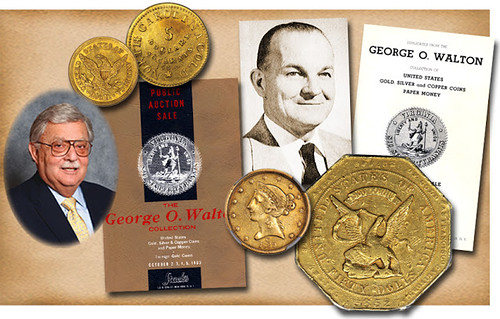
George Walton had vast holdings of Charlotte and Dahlonega gold coins, plus the coins of the Bechtler family and Templeton Reid, as well as a large collection of paper money, including southern state bank notes, issued and used prior to the Civil War, and Confederate currency. For more information about the man, I reference what was written in a Stack’s catalog of his collection offered in 1963. As early as 1937 George Walton was well known to the Stack family. He would visit our shop and talk for hours with Joseph and Morton. They were amazed at how much this young man knew about southern currency. From these early encounters a mutual friendship and respect grew. When the Stacks needed guidance on the history and money of the pre-Civil War period, George Walton’s great knowledge in this area was put to use.
George O. Walton was active in the American Numismatic Association, attended most conventions and also formed or participated in numerous coin clubs in the southeastern United States. Part of his livelihood came from being a bank inspector and appraiser for banks in the Carolinas, George, northern Florida and the mountainous areas of Virginia and Maryland. As he traveled through the towns and cities of these areas he made many friends and was also able to buy and sell southern gold coins and early paper money. Among the people served was the Reynolds family of tobacco fame and Dr. Conway Bolt, whose collection Stack’s sold in the early 1970s.
Beyond his affection for southern gold, Walton also had substantial holdings of territorial gold, not only the private gold of the Carolinas and Georgia. He often had a quantity of $50 gold pieces with him as well as those that remained in his bank) and loved to display them at ANA shows. He had a friendly rivalry with Amon Carter, Jr. who also had a large collection. At one point, some other collectors challenged them that they could not put together an exhibit of more than 100 pieces. George and Amon accepted the challenge and at the next ANA convention, between them they showed 101 territorial gold slugs, octagonal and round. It was like seeing the contents of a Wells Fargo chest on display. The challengers could not believe their eyes and never underestimated George or Amon again.
Unfortunately George, this knowledgeable numismatist and great friend of so many, was in a fatal automobile accident in 1962, on his way to a meeting of the Wilson-Goldsboro Coin Club. As was his style, he had with him many coins and these ended up spread over the highway. The police closed down the road and officers were assigned the task of picking up what they could find. Much was retrieved (but likely not all). After the collection was reassembled, it was given to Stack’s to sell at public auction by the Colonial-American National Bank of Roanoke, Virginia, who were the administrators of Walton’s estate.
The collection was so voluminous that it took two Stack’s catalogs to present it for sale. The Charlotte and Dahlonega gold and the private gold coins of the Bechtlers and Templeton Reid would have been a landmark sale on their own. But George Walton had gold coins of all denominations in quantity.
The legacy of George O. Walton is what his collection did for today’s collectors. By accumulating (some might say hoarding) coins from the Charlotte and Dahlonega mints he may have saved many of them from the melting pot. While people in the South did recognize these coins as their “local” currency and saved them, when the U.S. government in 1934 called in gold coins, many of these rarer pieces were turned in and melted along with more common gold.
It was lucky that George Walton and other collectors of the period understood the rarity of these coins and sought them out. His trips throughout the South buying coins put many coins in his collection and the collections of those he sold them to, instead of the melting pot.
Also in the Walton “Hoard” were the private gold coins issued by the Bechtler family during the 1830s, which made the gold found in the Carolina and Georgia hills usable as currency for goods and services in that area. The size of this accumulation, in today’s term, is almost unimaginable. George Walton had many hundreds of these pieces, which Stack’s offered in both of the sales, with particularly large lots sold in the October “main” sale.
By having so many coins to offer, collectors at the sale and those who came later had a good supply of these rare federal gold issues, which kept them more affordable. If all these coins had been melted in the 1930s, the cost of the surviving coins would have been many times what they are today. His legacy was to make collecting these coins possible for the numismatists of the future, in much the same manner that the famous Colonel E.H.R. Green saved pre-1834 $5 and $10 gold coins from the same melting pot.
To read the complete articles, see:
Remember When: George O. Walton, Part 1
(stacksbowers.com/Blogs/remember-when-george-o-walton-part-1.html)
Remember When: George O. Walton, Part 2
(stacksbowers.com/Blogs/remember-when-george-o-walton-part-2.html)
SOME OLYMPIC GOLD MEDALS TO CONTAIN RUSSIAN METEORITE FRAGMENTS
 An Olympic gold medal is already a difficult, rare item to attain. And next year, winter Olympians will have an opportunity to win a gold medal that's even more rare. Come February, the seven finalists standing on the tallest part of the podium in Sochi, Russia will be awarded medals made of gold and metal from outer space.
An Olympic gold medal is already a difficult, rare item to attain. And next year, winter Olympians will have an opportunity to win a gold medal that's even more rare. Come February, the seven finalists standing on the tallest part of the podium in Sochi, Russia will be awarded medals made of gold and metal from outer space.
Earlier this year, a meteor the size of a bus slammed into the Russian city of Chelyabinsk with the force of 20 atom bombs, generating much spectacular dashcam footage on YouTube. Fragments of that meteorite have been harvested and will be machined into the medals themselves, creating a gold and chondrite disc that only a handful of people on the Earth will ever wear around their necks. "We will hand out [the special] medals to all the athletes who will win gold on that day," said Chelyabinsk Region Culture Minister Alexei Betekhtin, "because both the meteorite strike and the Olympic Games are the global events."
Chelyabinsk and Sochi are not geographically close; the chondrite-infused medals will travel some 2,700 kilometers from the first city to the second. But the original meteor, of course, traveled quite a bit further than that.
To read the complete article, see:
Seven Olympians To Win Gold Medals Made With Meteorite Fragments
(www.core77.com/blog/materials/seven_olympians_to_win
_gold_medals_made_with_meteorite_fragments_25274.asp)
THE BOOK BAZARRE
SMITHSONIAN CURATOR KAREN LEE VISITS SRI LANKA
Karen Lee of the National Numismatic Collection at the Smithsonian recently visited Sri Lanka, where she met longtime E-Sylum contributor Kavan Ratnatunga. Kavan writes:
Ms Karen Lee's one week visit to Sri Lanka was very useful for the Numismatic community in Colombo. Members of the Sri Lanka Numismatic Society met up with her for Lunch on Monday 22nd. She did a 3 day workshop on Museum Studies from 23 to 25th at the Colombo National Museum which included a Public Lecture on 24th on "The Power of Museums" of which a Transcript is posted at http://www.archaeology.lk/public-lecture/the-power-of-museums/ and a session on "Research Methods and managements of Numismatic collections" on the 25th. She went on a 2 day trip to Kandy and Sigiriya. Her interview appears in the Sunday Times
Karen adds:
The collectors all brought coins to show me---ancient to modern---it was wonderful…the time I spent with that group was instructive, inspiring and really fun!
“Museums around the world are struggling with why they matter within society,” Karen says. “Everybody feels like the internet has definitely levelled the playing field.” Museums can no longer lay claim to being the solitary storehouses of knowledge and information is abundant (even if some of it is inaccurate). “If that’s not what museums are good for, what are we good for in the 21st century?” she asks. “It’s about taking a hard look at what we do and who we do it for.” In Colombo last week at the behest of the American Centre, she delivered a lecture on ‘The Power of Curating: Making Museums Come Alive’.
Karen ties her talk into her theme of re-examining her approach as a curator – “It’s about involving different communities, people whose voices don’t necessarily feel like they previously belonged.”
There is also another reason Karen would have laughed if someone had told her where she’d end up – she didn’t have the slightest interest in numismatics or the study of coins and currency until she walked into that Smithsonian’s Numismatic Department 10 years ago. She was called in to help manage a crisis. The institution’s decision to ‘mothball’ a celebrated coin exhibit had sparked public uproar. Her mandate was to do a little triage work, find some funds and get a small exhibit opened again.
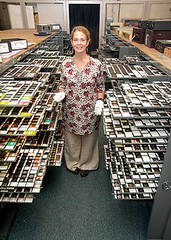 “But after I raised the money, built the exhibit, got to know the senior curator, I absolutely fell in love with the collection and I just didn’t want to leave it to go off and work on someone else’s crisis,” she says, revealing it marked the beginning of a very real affection for numismatics.
“But after I raised the money, built the exhibit, got to know the senior curator, I absolutely fell in love with the collection and I just didn’t want to leave it to go off and work on someone else’s crisis,” she says, revealing it marked the beginning of a very real affection for numismatics.
Having graduated with a degree in biology, with a Masters in Museum Science tacked on later, Karen is largely self-taught. “Actually, I like to tell women and girls this about myself,” she says, explaining that she uses her personal journey to illustrate how simply embracing curiosity can lead you in unexpected and wonderful directions. Karen is keenly aware of how female numismatists are a rare breed in the U.S. She says thinking about how to display, interpret and position the Smithsonian’s many numismatic objects so that they resonate better with women is a focus for her personally.
Karen has worked at the Smithsonian for close on 30 years (she actually started out as a research assistant in the botany department). Working in the world’s biggest museum complex is simply “awesome”, says Karen. She counts herself particularly lucky, that the objects of her fascination – some 1.5 million numismatic treasures – are all stored in a vault in the same building.
As lucky as she counts herself to be working at the Smithsonian, she says expecting everyone who wants to see these historical riches to visit the museum is both “impractical” and “not collaborative.” Its why, despite being initially sceptical about the public’s interest, she created the Smithsonian travelling coin programme. As part of it, the Smithsonian agreed to take one of their most prized coins on a tour of seven European cities. Though 500,000 of these gold coins were originally minted, only 13 ‘Double Eagles’ survive today. The historical value of these 13 were multiplied exponentially when the rest were melted down to help to stabilise the American economy by removing gold from circulation during the Great Depression.
Accompanying the coin, Karen was astounded when the final tally came in – an estimated 10 million people had encountered the exhibit in some form, whether through the many media events like the BBC talk show or directly, in person. People standing for hours in a queue in Prague gently corrected her when she asked why they were so interested in American history – it was a piece of world history they had come to see, they said.
To read the complete article, see: Making museums come alive (www.sundaytimes.lk/130728/plus/making-museums-come-alive-54415.html)
JANE AUSTEN BANKNOTE PROMOTER THREATENED
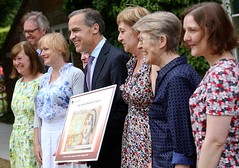 It was a genteel campaign to ensure that British bank notes would continue to carry images of women, and it could have ended with the announcement last month that Jane Austen, the much-beloved novelist, would replace Charles Darwin on the £10 note.
It was a genteel campaign to ensure that British bank notes would continue to carry images of women, and it could have ended with the announcement last month that Jane Austen, the much-beloved novelist, would replace Charles Darwin on the £10 note.
Instead, a countercampaign of online harassment, including threats of rape and death, against several high-profile women here turned so nasty that Twitter took steps this weekend to tighten its global policy on reporting abuse.
There has been plenty of pride, but also a good dose of prejudice, as a small band of feminists in period costumes has initiated a national debate about power, rape and the limits of free speech in the age of social media.
Caroline Criado-Perez, a blogger and co-founder of the Web site The Women’s Room, began her campaign months ago when she realized that soon there might be no women — except Queen Elizabeth II, of course — left on British bank notes. The issue seemed urgent: in April, the Bank of England had announced that the only woman currently featured among five historical figures, the social reformer Elizabeth Fry, would be replaced by Winston Churchill, indisputably male.
The departing governor of the bank, Mervyn A. King, fond of pointing out that one woman, the queen, is on the back of every bill and coin, appeared to have little time for the debate.
But in July he was replaced by a younger man, a Canadian named Mark J. Carney, the first non-Briton to run the bank in its 319-year history. Mr. Carney seized the opportunity to make a gesture.
On July 24, Mr. Carney said that it had always been the bank’s intention to include another woman among the historical figures on the bank notes, and he announced that Austen would appear on future £10 notes. He also vowed to review the whole process of choosing historical figures for the notes.
“A brilliant day for women,” Ms. Criado-Perez said in response.
But that same day on Twitter a trickle of abuse grew into a shower of crude rape and death threats against Ms. Criado-Perez at a rate of nearly one per minute. Several other women, from members of the public to members of Parliament, have also been the targets of Twitter attacks. Three female journalists received bomb threats.
Twitter, under pressure after receiving an online petition with at least 124,000 signatures, announced Saturday on its site that it was introducing a new one-click button to report abuse on every post. The new feature will help users navigate their way to an online form. The company also pledged to dedicate more staff members to identifying abusive posts and is updating its rules, stating explicitly that it will not tolerate abuse.
Tony Wang, who runs Twitter’s British operation, posted a personal apology “to the women who have experienced abuse on Twitter.”
The abuse is “not acceptable in the real world, and it’s not acceptable on Twitter,” he said. He added, “There is more we can and will be doing to protect our users against abuse.”
To read the complete article, see: Bid to Honor Austen Is Not Universally Acknowledged (www.nytimes.com/2013/08/05/world/europe/bid-to-honor-austen-is-not-universally-acknowledged.html)
Responding to last week's article, Joe Boling writes:
I quote: "The move comes after the Bank faced criticism that a plan for Winston Churchill to feature on the new fiver meant there would not be a woman on any English note." When did Queen Elizabeth become male?
To read the earlier E-Sylum article, see: JANE AUSTEN TO APPEAR ON BANK OF ENGLAND £10 NOTE (www.coinbooks.org/esylum_v16n31a14.html
ISAAC NEWTON'S DEATH MASK
 The death mask is a curious historical niche which attracts considerable interest. They are made by taking a cast of the face in wax or plaster, usually hours after death. Before photography, they were the most truthful representation of the departed. Such masks have been found in ancient Egyptian tombs, archaeological sites in the near east and Roman portrait sculptures.
The death mask is a curious historical niche which attracts considerable interest. They are made by taking a cast of the face in wax or plaster, usually hours after death. Before photography, they were the most truthful representation of the departed. Such masks have been found in ancient Egyptian tombs, archaeological sites in the near east and Roman portrait sculptures.
In the seventeenth century it was common for the death mask to be used as part of the effigy of the deceased, and as an aid to portrait sculptures for tomb effigies. Then there were those used for art and representations of famous events, the most noted proponent being Madame Tussaud. She learned the process from her uncle Philippe Curtius, a Swiss physician who had turned his hobby into a lucrative trade.
The Royal Society holds two death masks. The first, of Sir Isaac Newton, is made of plaster with a wax coating. It was the work of the sculptor John Michael Rysbrack, and was used in the preparation of Newton’s memorial in Westminster Abbey, before being purchased and presented to the Society in 1839 by Samuel Hunter Christie FRS. Newton is one of the best known of our Fellows, and was President from 1703 to his death in 1727. The mask seems to be a rather tasteful one, and is one of our most iconic treasures; it was scanned in 3D last year by the Cambridge Microsoft Research Laboratory.
Masks could also be made of the living. In 1669, four years after he had been elected a Fellow, Samuel Pepys took the fashionable step of having a life mask made. He describes the experience as follows: “I was vexed to be forced to daub all my face over with Pomatum [scented ointment], but it was pretty to feel how soft and easy it is done on the face, and by and by, by degrees, how hard it becomes, that you cannot break it, and sets so close that you cannot pull it off, and yet so easy that is as soft as a pillow.” For Pepys, the slight feeling of claustrophobia came second to his enduring curiosity – a trait expected to be displayed by a Fellow of the Royal Society!
To read the complete article, see: Death masks (blogs.royalsociety.org/history-of-science/2013/08/06/death-masks/)
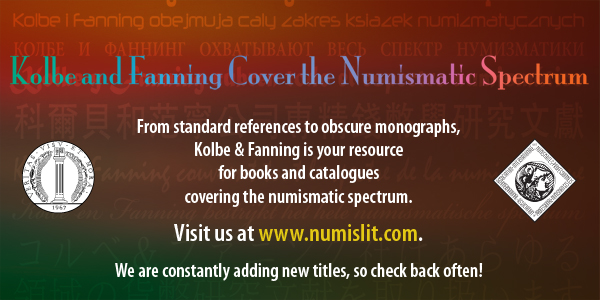
MISSING KEYS SEARCH LEADS TO 14 MEDIAEVAL COINS
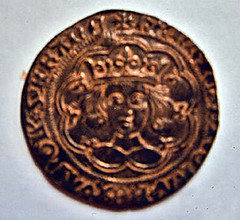 When farmer Ifor Edwards dropped his keys in a field he had no idea the search to find them would result in the discovery of buried treasure.
When farmer Ifor Edwards dropped his keys in a field he had no idea the search to find them would result in the discovery of buried treasure.
Mr Edwards, 56 and his wife Anna, 40, called in enthusiasts from Wrexham Heritage Society when he lost his keys on land at Oak Farm in Bronington, near Whitchurch.
But as well as finding his keys – which had gone through a lawn mower – the team armed with metal detectors also found 14 mediaeval coins dated from the 14th and 15th centuries.
At an inquest in Ruthin the North East Wales Coroner John Gittins declared the coins – from the reigns of Edward III, Henry V and Henry VI – as treasure.
Mr Edwards said: “It is a once in a lifetime thing.
“It is such a shock, you just can’t quite believe it.
“You realise those coins were there before they ever found America or anything.
“You just can’t believe you’re holding something that is 600 and something years old.
“We only bought the land three years ago and nothing like this has ever been found before.”
To read the complete article, see: Missing keys hunt unearths treasure trove find (www.shropshirestar.com/news/2013/07/29/missing-keys-hunt-unearths-treasure-trove-find/)
'LOVEABLE ROGUE' COUNTERFEITER THOMAS MCANEA DIES
 On the face of it, he ran a tiny printer’s shop, apparently producing nothing more exciting than menus for Chinese restaurants.
On the face of it, he ran a tiny printer’s shop, apparently producing nothing more exciting than menus for Chinese restaurants.
Behind the scenes, however, Thomas McAnea was a master forger at the centre of a major counterfeiting operation with the power to threaten Britain’s economic stability.
Nicknamed ‘Hologram Tam’, McAnea relied on just a few simple tools – a pair of spectacles, a magnifying glass and an engraving pen – to produce the detailing on fake banknotes so authentic that by the time he was caught nearly £700,000 worth were in circulation.
Yet, despite his fabled ability to conjure up dodgy currency, McAnea, whose death from lung cancer at the age of 63 was reported yesterday, could scarcely be said to have cashed in on his dubious talents.
Police sources say he appeared to have barely two pennies to rub together at his death and, in the greatest of ironies, the illness which killed him is believed to have been caused by a lifetime spent inhaling toxic printing fumes.
A family friend said: ‘Tam was a lovable rogue but one of the biggest names in crime.
‘It’s a bit ironic he got lung cancer from printing – the job where he made his name as the forgery master. There will be a big turnout at his funeral.’
McAnea, who died at his home in Glasgow on Friday, was jailed for six years and four months in 2007 after he was unmasked as the ringleader of a professional gang which had the capacity to pump out £2million worth of fake notes a day.
His tiny shop, Print Link (Scotland), at St George’s Cross, Glasgow, appeared to offer small-scale printing, mainly menus for Chinese restaurants.
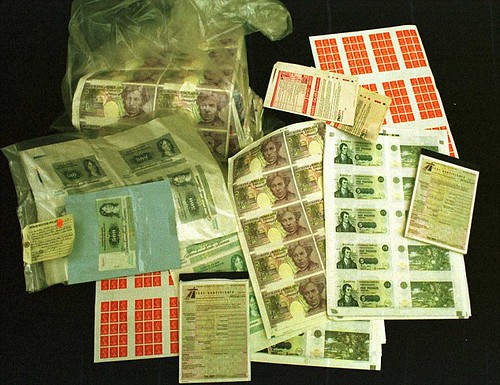
Scottish Labour Justice Spokesman Graeme Pearson, who was director of the SCDEA when McAnea was caught, said the former print union official ‘had the touch of the geek about him’, but added: ‘People think it’s a bit of a wheeze, a B movie, producing banknotes in your kitchen, but in actual fact what we have is something that enables criminal gangs to profit.
‘This counterfeiting gang had the ability to destabilise the British economy.’
To read the complete article, see: Master banknote forger who could have crippled Britain's economy dies from cancer after lifetime spent inhaling toxic printing fumes (www.dailymail.co.uk/news/article-2385280/Master-bank-note-forger-crippled-Britains-economy-dies-cancer-lifetime-spent-inhaling-toxic-printing-fumes.html)
FACEBOOK IMAGES LEAD TO COUNTERFEITER ARRESTS
Facebook pictures of several counterfeit $20 bills led to the arrest of a Tallahassee man Thursday.
Dante J. Coates, 26, was arrested on charges of possessing counterfeit money after investigators discovered pictures of the bills on his personal social media profile with several identical partial serial numbers visible next to his apartment complex identification.
According to the arrest report, one bill in the picture, with the full serial number visible, was identical to one passed by Brandilyn Gentry, who was arrested July 27 for possessing and passing counterfeit money. Gentry told investigators Coates had given her the money.
Investigators interviewed Coates who said he posted the picture after Gentry let him hold the money, but had originally said he had nothing to do with Gentry’s acquisition of the money.
Coates and Gentry were both released from the Leon County Jail on $1,000 bonds.
To read the complete article, see: Facebook pictures lead to arrest for counterfeit money (www.tallahassee.com/article/20130802/NEWS01/130802009/Facebook-pictures-lead-arrest-counterfeit-money-)
FEATURED WEB PAGE: COIN HOARDS OF THE ROMAN REPUBLIC ONLINE
This week's Featured Web Page is Coin hoards of the Roman Republic Online, hosted on the site of the American Numismatic society.Coin Hoards of the Roman Republic Online (CHRR Online) is a database of Roman Republican coin hoards mainly from the period 155 BC to AD 2. This database began life as a personal research database constructed by Kris Lockyear using a combination of published data and Michael Crawford's personal archive now housed in the British Museum. The online database, which utilises the Numishare application developed by Ethan Gruber, is a joint project between Kris Lockyear (Institute of Archaeology, University College London) and the American Numismatic Society. Project coordination provided by Rick Witschonke of the ANS.

numismatics.org/chrr/
